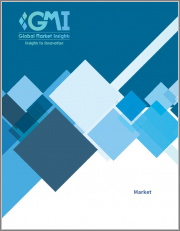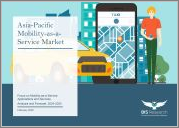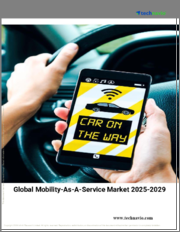
|
시장보고서
상품코드
1384308
세계 MaaS(Mobility as a Service) 시장 규모 - 서비스 유형별, 비즈니스 모델별, 운송 유형별, 솔루션 유형별, OS별, 요건 유형별 예측(2023-2032년)Mobility as a Service Market Size - By Service Type, Business Model, Transportation Type, Solution Type, OS, Requirement Type & Forecast, 2023 - 2032 |
||||||
MaaS(Mobility as a Service) 시장 규모는 스마트시티 구상의 세계 급증을 배경으로 2023년부터 2032년에 걸쳐 CAGR 9% 이상으로 확대할 전망입니다.
세계 각국의 정부는 교통 효율을 높이기 위해 여러 기술을 통합하는 도시 개발 전략에 투자하고 있습니다. MaaS는 도시 이동성에 대한 종합적이고 상호 연결적인 접근 방식을 제공하기 때문에 이러한 노력과 원활하게 협력함으로써 높은 수요가 예상됩니다.
또한 IoT, 실시간 데이터 분석, MaaS 산하의 다양한 운송 수단의 원활한 통합을 가능하게 하는 혁신적인 모바일 앱 개척 등 기술의 급속한 진보도 시장의 강력한 성장에 기여할 것으로 보입니다. 예를 들어, 벨기에 브뤼셀의 대형 대중교통기관 운영회사 STIB-MIVB는 2023년 9월, 시내의 각종 교통기관의 계획, 예약, 지불을 가능하게 하는 새로운 MaaS(Mobility as a Service) 앱을 발표 했습니다.
MaaS 업계는 서비스 유형, 비즈니스 모델, 솔루션, 교통, 용도 플랫폼, 요구 사항, 지역으로 구분됩니다.
서비스 유형별로 효율적인 마지막 마일 연결에 대한 선호도가 높아짐에 따라 마이크로 이동성 세분화 시장 점유율이 2032년 말까지 큰 수익을 창출할 것으로 보입니다. 전동 스쿠터나 전동 자전거 등 콤팩트하고 단거리 이동 수단을 특징으로 하는 마이크로모빌리티는 도시의 통근자에게 지속 가능하고 편리한 옵션으로 주목도가 높아지고 있습니다. 따라서 초소형 모빌리티 서비스를 제공하는 기업은 최근 이용자 증가를 목격하고 있으며, 이 분야의 성장을 뒷받침하고 있습니다.
교통기관유형별로는 대중교통기관의 서비스로서의 모빌리티 시장은 2023년부터 2032년에 걸쳐 큰 성장이 예상됩니다. 각 도시에서 도시화가 진행됨에 따라 효율적이고 상호 연결된 대중 교통 솔루션에 대한 수요가 급증하고 있습니다. 또한 실시간 정보, 발권 및 멀티 모달 여행 계획의 편의성이 대중 교통 이용자 증가에 기여하고 있습니다. 대중교통 인프라 강화를 위한 정부의 이니셔티브와 투자의 급증도 이 분야의 성장을 뒷받침할 것으로 예상됩니다.
지역별로 아시아태평양의 MaaS 산업은 2022년에 견조한 CAGR을 보여주며 지속가능한 교통 솔루션에 대한 요구의 고조가 원동력이 되어 2032년까지 꾸준한 확대가 예상됩니다. 이 대륙의 다양하고 인구 밀도가 높은 도시는 MaaS 혁신에 적합한 환경을 만들어 업계 선수에게 유리한 성장 기회를 제공합니다. 예를 들어, 2023년 7월, 공유 전동 이륜차 플랫폼으로 유명한 Yulu는 Last One Miles Delivery 지역에서 MaaS 제품을 발표하고 인도 그루그램에 기반을 확장했습니다. 또한 하이테크에 정통한 인구의 존재와 스마트폰의 보급도 지역산업 확대에 박차를 가할 것으로 보입니다.
목차
제1장 조사 방법과 조사 범위
제2장 주요 요약
제3장 MaaS(Mobility as a Service) 업계 인사이트
- COVID-19의 영향
- 러시아·우크라이나 전쟁의 영향
- 생태계 분석
- 벤더 매트릭스
- 이익률 분석
- 기술과 혁신의 전망
- 특허 분석
- 주요 뉴스와 이니셔티브
- 파트너십 및 협업
- 합병 및 인수
- 투자
- 자주성의 레벨 시작과 혁신
- 규제 상황
- 영향요인
- 성장 촉진요인
- 도시화 진전과 교통 정체
- 스마트폰과 첨단 교통 앱의 보급
- 결제 서비스 통합
- 데이터 분석과 AI 채용 증가
- 업계의 잠재적 위험 및 과제
- 인프라와 통합에 대한 우려
- 성장 촉진요인
- 성장 가능성 분석
- Porter's Five Forces 분석
- PESTEL 분석
제4장 경쟁 구도
- 소개
- 기업별 시장 점유율
- 주요 시장 기업의 경쟁 분석
- MOBIKO
- Europcar
- Curb Mobility
- Uber Technologies Inc.
- HERTZ SYSTEM, INC.
- Beijing Xiaoju Technology Co., Ltd
- 경쟁 포지셔닝 매트릭스
- 전략 전망 매트릭스
제5장 MaaS(Mobility as a Service) 시장 추계 및 예측 : 서비스별
- 주요 동향 : 서비스별
- 라이드 헤일링
- 카셰어링
- 마이크로 이동성
- 버스 공유
- 철도 서비스
제6장 MaaS(Mobility as a Service) 시장 추계 및 예측 : 비즈니스 모델별
- 주요 동향 :비즈니스 모델별
- B2B
- B2C
- P2P
제7장 MaaS(Mobility as a Service) 시장 추계 및 예측 : 솔루션별
- 주요 동향 : 솔루션별
- 기술 플랫폼
- 결제 엔진
- 네비게이션 솔루션
- 통신 접속 제공업체
- 보험 서비스
제8장 MaaS(Mobility as a Service) 시장 추계 및 예측 : 수송별
- 주요 동향 : 수송별
- 민간
- 공공
제9장 MaaS(Mobility as a Service) 시장 추계 및 예측 : OS별
- 주요 동향 : OS별
- IOS
- 안드로이드
- 기타
제10장 MaaS(Mobility as a Service) 시장 추계 및 예측 : 요건별
- 주요 동향 : 요건별
- 첫 마일 및 마지막 마일 연결
- 오프 피크 및 시프트 근무 통근
- 매일 통근
- 공항이나 대중교통에의 액세스
- 도시간 여행
- 기타
제11장 MaaS(Mobility as a Service) 시장 추계 및 예측 : 지역별
- 주요 동향 : 지역별
- 북미
- 미국
- 캐나다
- 유럽
- 독일
- 영국
- 프랑스
- 이탈리아
- 러시아
- 네덜란드
- 스페인
- 아시아태평양
- 중국
- 인도
- 일본
- 한국
- 뉴질랜드
- 동남아시아
- 라틴아메리카
- 브라질
- 멕시코
- 아르헨티나
- 중동 및 아프리카
- UAE
- 남아프리카
- 사우디아라비아
제12장 기업 프로파일
- ANI Technologies Pvt. Ltd.
- Aptiv
- Avis budget group
- Beijing Xiaoju Technology Co, Ltd.
- Bird
- BlaBlaCar
- Bolt Technology OU
- car2go NA, LLC
- Careem
- Curb Mobility
- Enterprise Holdings Inc.
- Europcar
- Gett
- HERTZ SYSTEM, INC.
- Lime
- Lyft, Inc.
- Mobiag,
- MOBIKO
- Moovel group
- movmi Shared Transportation Services Inc.
- Uber Technologies Inc.
- Whim
- Wingz
Mobility as a Service (MaaS) Market size is poised to expand at over 9% CAGR from 2023 to 2032 attributed to the global surge in smart city initiatives. Governments worldwide are investing in urban development strategies for integrating several technologies to enhance transportation efficiency. MaaS is witnessing high demand as it aligns seamlessly with these initiatives for offering comprehensive and interconnected approach to urban mobility.
Moreover, rapid advancements in technology, including IoT, real-time data analytics, and the development of innovative mobile apps to enable seamless integration of various transportation modes under the MaaS umbrella will also contribute to strong market growth. For instance, in September 2023, STIB-MIVB, a major public transportation operator in Brussels, Belgium, launched a new mobility-as-a-service app to allow users to plan, book, and pay for various types of transportation inside the city.
The MaaS industry is segmented into service type, business model, solution, transportation, application platform, requirement, and region.
Based on service type, the market share from the micro-mobility segment is poised to generate substantial revenue by the end of 2032 owing to the increasing preference for efficient last-mile connectivity. Micro-mobility, characterized by compact, short-distance transportation solutions, such as electric scooters and bikes is gaining increasing prominence as a sustainable and convenient option for urban commuters. To that end, companies offering micro-mobility services are witnessing increased user adoption in recent years, boosting the segment growth.
In terms of transportation type, the mobility as a service market from the public transport segment is anticipated to depict considerable growth from 2023 to 2032. The rising urbanization across cites is surging the demand for efficient and interconnected public transportation solutions. Moreover, the convenience of real-time information, ticketing, and multi-modal trip planning is contributing to increased public transport ridership. The surge in government initiatives and investments for enhancing public transportation infrastructure is also expected to bolster the segment growth.
Regionally, the Asia Pacific MaaS industry exhibited robust CAGR in 2022 and is anticipated to witness steady expansion through 2032 driven by the increasing need for sustainable transportation solutions. The diverse and densely populated cities in the continent are creating a ripe environment for MaaS innovations, providing industry players with lucrative growth opportunities. For instance, in July 2023, Yulu, the renowned shared electric two-wheeler platform, expanded its footprint in Gurugram, India, with the launch of MaaS products in the last-mile delivery area. Moreover, the presence of tech-savvy population and the proliferation of smartphone usage will also add to the regional industry expansion.
Table of Contents
Chapter 1 Methodology & Scope
- 1.1 Market scope & definition
- 1.2 Base estimates & calculations
- 1.3 Forecast calculation
- 1.4 Data sources
- 1.4.1 Primary
- 1.4.2 Secondary
- 1.4.2.1 Paid sources
- 1.4.2.2 Public sources
Chapter 2 Executive Summary
- 2.1 Mobility as a Service (MaaS) market 360 degree synopsis, 2018 - 2032
- 2.2 Business trends
- 2.2.1 Total Addressable Market (TAM), 2023-2032
- 2.3 Regional trends
- 2.4 Service type trends
- 2.5 Business model trends
- 2.6 Solution type trends
- 2.7 Transportation type trends
- 2.8 Application platform trends
- 2.9 Requirement type trends
- 2.10 Organization size trends
Chapter 3 Mobility as a Service (MaaS) Industry Insights
- 3.1 Impact of COVID-19
- 3.2 Impact of the Russia-Ukraine war
- 3.3 Industry ecosystem analysis
- 3.4 Vendor matrix
- 3.5 Profit margin analysis
- 3.6 Technology & innovation landscape
- 3.7 Patent analysis
- 3.8 Key news and initiatives
- 3.8.1 Partnership/Collaboration
- 3.8.2 Merger/Acquisition
- 3.8.3 Investment
- 3.8.4 Level of autonomy launch & innovation
- 3.9 Regulatory landscape
- 3.10 Impact forces
- 3.10.1 Growth drivers
- 3.10.1.1 Growing urbanization and traffic congestion
- 3.10.1.2 Proliferation of smartphones and advanced transportation apps
- 3.10.1.3 Integration of payment services
- 3.10.1.4 Increasing adoption of data analytics and AI
- 3.10.2 Industry pitfalls & challenges
- 3.10.2.1 Infrastructure and integration concerns
- 3.10.1 Growth drivers
- 3.11 Growth potential analysis
- 3.12 Porter's analysis
- 3.13 PESTEL analysis
Chapter 4 Competitive Landscape, 2022
- 4.1 Introduction
- 4.2 Company market share, 2022
- 4.3 Competitive analysis of major market players, 2022
- 4.3.1 MOBIKO
- 4.3.2 Europcar
- 4.3.3 Curb Mobility
- 4.3.4 Uber Technologies Inc.
- 4.3.5 HERTZ SYSTEM, INC.
- 4.3.6 Beijing Xiaoju Technology Co., Ltd
- 4.4 Competitive positioning matrix, 2022
- 4.5 Strategic outlook matrix, 2022
Chapter 5 Mobility as a Service (MaaS) Market Estimates & Forecast, By Services (Revenue)
- 5.1 Key trends, by service
- 5.2 Ride Hailing
- 5.3 Car Sharing
- 5.4 Micro Mobility
- 5.5 Bus Sharing
- 5.6 Train Services
Chapter 6 Mobility as a Service (MaaS) Market Estimates & Forecast, By Business Model (Revenue)
- 6.1 Key trends, by business model
- 6.2 B2B
- 6.3 B2C
- 6.4 P2P
Chapter 7 Mobility as a Service (MaaS) Market Estimates & Forecast, By Solutions (Revenue)
- 7.1 Key trends, by solution
- 7.2 Technology Platforms
- 7.3 Payment Engines
- 7.4 Navigation Solutions
- 7.5 Telecom Connectivity Providers
- 7.6 Insurance Services
Chapter 8 Mobility as a Service (MaaS) Market Estimates & Forecast, By Transportation (Revenue)
- 8.1 Key trends, by transportation
- 8.2 Private
- 8.3 Public
Chapter 9 Mobility as a Service (MaaS) Market Estimates & Forecast, By OS (Revenue)
- 9.1 Key trends, by OS
- 9.2 IOS
- 9.3 Android
- 9.4 Others
Chapter 10 Mobility as a Service (MaaS) Market Estimates & Forecast, By Requirements (Revenue)
- 10.1 Key trends, by requirements
- 10.2 First & Last Mile Connectivity
- 10.3 Off-Peak & Shift Work Commute
- 10.4 Daily Commuter
- 10.5 Airport or Mass Transit Stations Trips
- 10.6 Inter-City Trips
- 10.7 Others
Chapter 11 Mobility as a Service (MaaS) Market Estimates & Forecast, By Region (Revenue)
- 11.1 Key trends, by region
- 11.2 North America
- 11.2.1 U.S.
- 11.2.2 Canada
- 11.3 Europe
- 11.3.1 Germany
- 11.3.2 UK
- 11.3.3 France
- 11.3.4 Italy
- 11.3.5 Russia
- 11.3.6 Netherlands
- 11.3.7 Spain
- 11.4 Asia Pacific
- 11.4.1 China
- 11.4.2 India
- 11.4.3 Japan
- 11.4.4 South Korea
- 11.4.5 ANZ
- 11.4.6 Southeast Asia
- 11.5 Latin America
- 11.5.1 Brazil
- 11.5.2 Mexico
- 11.5.3 Argentina
- 11.6 MEA
- 11.6.1 UAE
- 11.6.2 South Africa
- 11.6.3 Saudi Arabia
Chapter 12 Company Profiles
- 12.1 ANI Technologies Pvt. Ltd.
- 12.2 Aptiv
- 12.3 Avis budget group
- 12.4 Beijing Xiaoju Technology Co, Ltd.
- 12.5 Bird
- 12.6 BlaBlaCar
- 12.7 Bolt Technology OU
- 12.8 car2go NA, LLC
- 12.9 Careem
- 12.10 Curb Mobility
- 12.11 Enterprise Holdings Inc.
- 12.12 Europcar
- 12.13 Gett
- 12.14 HERTZ SYSTEM, INC.
- 12.15 Lime
- 12.16 Lyft, Inc.
- 12.17 Mobiag,
- 12.18 MOBIKO
- 12.19 Moovel group
- 12.20 movmi Shared Transportation Services Inc.
- 12.21 Uber Technologies Inc.
- 12.22 Whim
- 12.23 Wingz



















